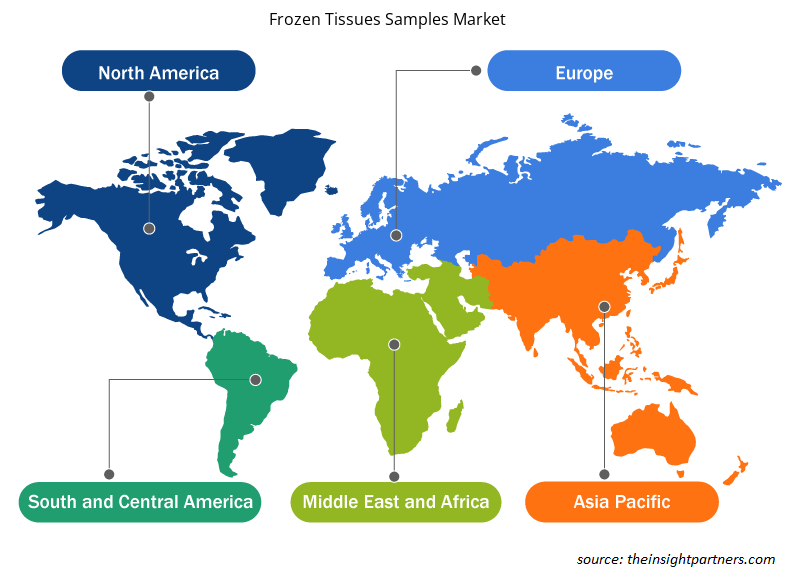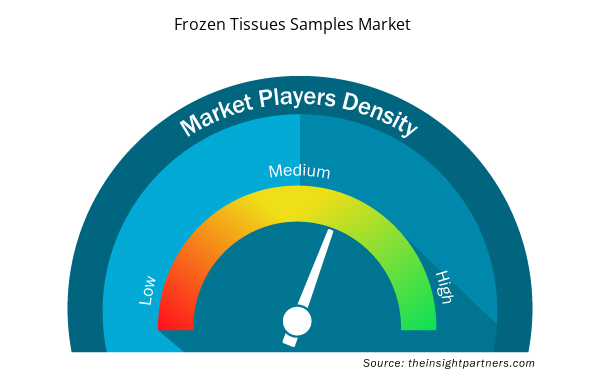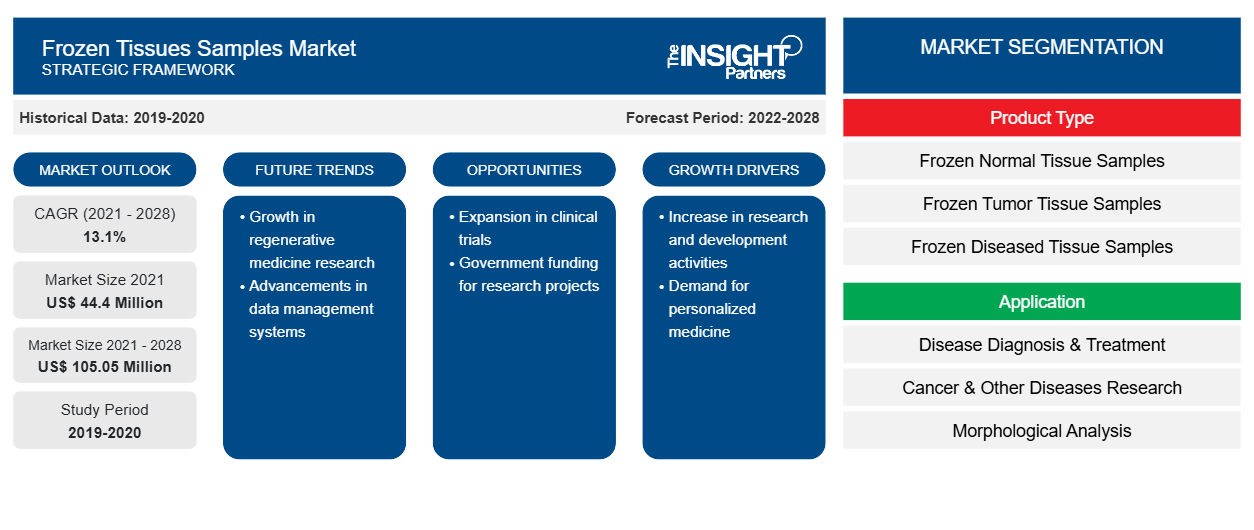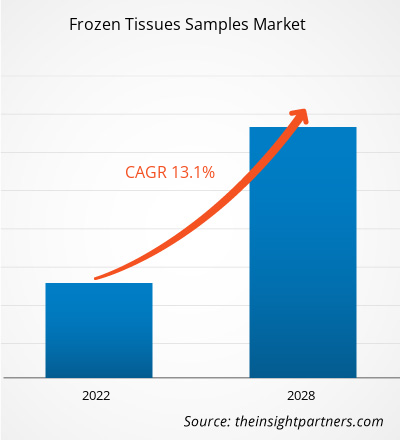Der Markt für gefrorene Gewebeproben soll von 44.399.070 US-Dollar im Jahr 2021 auf 105.045.910 US-Dollar im Jahr 2028 anwachsen. Der Markt soll im Zeitraum 2021–2028 mit einer durchschnittlichen jährlichen Wachstumsrate von 13,1 % wachsen.
Gefrorene Gewebeproben werden bevorzugt für Analysen wie Next-Generation-Sequencing , Western Blotting für posttranslationale Proteinmodifikationen, Massenspektrometrie und quantitative Echtzeit-Polymerase-Kettenreaktion verwendet. Gefrorene Gewebeproben sind der Goldstandard für die DNA- und RNA-Sequenzierung, insbesondere wenn die Stränge länger als 50 Paare sein müssen. Gefrorene Gewebeproben sind auch in der Immunhistochemie nützlich, da die Proteine noch in ihrem nativen Zustand erhalten bleiben.
Passen Sie diesen Bericht Ihren Anforderungen an
Sie erhalten kostenlose Anpassungen an jedem Bericht, einschließlich Teilen dieses Berichts oder einer Analyse auf Länderebene, eines Excel-Datenpakets sowie tolle Angebote und Rabatte für Start-ups und Universitäten.
- Holen Sie sich die wichtigsten Markttrends aus diesem Bericht.Dieses KOSTENLOSE Beispiel umfasst eine Datenanalyse von Markttrends bis hin zu Schätzungen und Prognosen.
Das globale Marktwachstum für gefrorene Gewebeproben ist auf die zunehmende Anwendung gefrorener Gewebeproben in verschiedenen Forschungs- und Therapiebereichen und die zunehmende Verwendung gefrorener Gewebeproben aufgrund der steigenden Krebsprävalenz zurückzuführen. Das mit der Konservierung und Aufbewahrung gefrorener Gewebeproben verbundene Risiko behindert jedoch in gewissem Maße das globale Marktwachstum für gefrorene Gewebeproben.
Zunehmende Verwendung von gefrorenen Gewebeproben aufgrund steigender Krebshäufigkeit
Laut den von Cancer Research UK im Jahr 2020 veröffentlichten Daten sterben in Großbritannien jedes Jahr rund 0,16 Millionen Menschen an Krebs. Darüber hinaus hat laut dem Globocan-Bericht im Jahr 2020 Brustkrebs bei Frauen Lungenkrebs als am häufigsten diagnostizierte Krebsart überholt, mit schätzungsweise 2,3 Millionen Neuerkrankungen (11,7 %), gefolgt von Lungenkrebs (11,4 %), Dickdarmkrebs (10,0 %), Prostatakrebs (7,3 %) und Magenkrebs (5,6 %). Lungenkrebs blieb mit schätzungsweise 1,8 Millionen Todesfällen (18 %) die häufigste durch Krebs diagnostizierte Todesursache, gefolgt von Dickdarmkrebs (9,4 %), Leberkrebs (8,3 %), Magenkrebs (7,7 %) und Brustkrebs bei Frauen (6,9 %). Die Gesamtinzidenz war in Übergangsländern zwei- bis dreimal höher als in Übergangsländern. Allerdings waren die Todesfälle durch Brust- und Gebärmutterhalskrebs bei Frauen in Übergangsländern deutlich höher als in Übergangsländern. Eine so hohe Krebsprävalenz erfordert den Bedarf an gefrorenen Gewebeproben für Forschung und Studien. Die zunehmenden Studien mit gefrorenen Tumorgewebeproben bieten mehrere Diagnose- und Behandlungsmöglichkeiten für diese chronische Erkrankung. Daher treibt die weltweit steigende Krebsinzidenz das Wachstum des Marktes für gefrorene Gewebeproben voran. Darüber hinaus ist Krebs in Kanada die häufigste Todesursache in der Bevölkerung und in den USA die zweithäufigste Todesursache nach Herzerkrankungen. Laut der American Cancer Society werden in den USA im Jahr 2022 etwa 1,9 Millionen neue Krebsfälle diagnostiziert und 609.360 Todesfälle geschätzt. Prostatakrebs ist die am häufigsten diagnostizierte Krebsart bei Männern in Nordamerika; bei Frauen ist Brustkrebs jedoch nach wie vor die häufigste. Darüber hinaus bleibt Lungenkrebs die häufigste Todesursache in der Bevölkerung. Es wird geschätzt, dass die Zahl der neuen Krebsfälle 439,2 pro 100.000 Männer und Frauen pro Jahr beträgt. Daher führt die zunehmende Verbreitung von Krebs in der Bevölkerung zum Wachstum des Marktes für gefrorene Gewebeproben weltweit.
Produktbasierte Erkenntnisse
Der globale Markt für gefrorene Gewebeproben ist je nach Produkt in gefrorene normale Gewebeproben, gefrorene Tumorgewebeproben und gefrorene erkrankte Gewebeproben unterteilt. Das Segment der gefrorenen Tumorgewebeproben hatte 2021 den größten Marktanteil. Darüber hinaus wird erwartet, dass dasselbe Segment im Prognosezeitraum von 2021 bis 2028 die höchste durchschnittliche jährliche Wachstumsrate (CAGR) auf dem Markt für gefrorene Gewebeproben verzeichnet. Das Wachstum ist hauptsächlich auf die weltweit zunehmende Zahl von Tumorfällen zurückzuführen.
Anwendungsbasierte Erkenntnisse
Basierend auf der Anwendung ist der globale Markt für gefrorene Gewebeproben in Krankheitsdiagnose und -behandlung, Krebs- und andere Krankheitsforschung sowie morphologische Analyse unterteilt. Im Jahr 2021 hatte das Segment Krebs- und andere Krankheitsforschung den größten Anteil am globalen Markt für gefrorene Gewebeproben. Es wird jedoch erwartet, dass das Segment Krankheitsdiagnose und -behandlung von 2021 bis 2028 mit 13,8 % das schnellste CAGR-Wachstum verzeichnet.
Endbenutzerbasierte Erkenntnisse
Der globale Markt für gefrorene Gewebeproben ist nach Endverbrauchern in akademische und Forschungsinstitute, Krankenhäuser und Kliniken, Diagnosezentren und andere unterteilt. Im Jahr 2021 hielt das Segment der akademischen und Forschungsinstitute den größten Anteil am globalen Markt für gefrorene Gewebeproben. Es wird jedoch erwartet, dass das Segment der Krankenhäuser und Kliniken von 2021 bis 2028 mit einer durchschnittlichen jährlichen Wachstumsrate von 13,9 % am schnellsten wächst.
Produkteinführungen und -zulassungen sind häufig von Unternehmen angewandte Strategien, um ihre globale Präsenz und ihr Produktportfolio zu erweitern. Darüber hinaus konzentrieren sich die Marktteilnehmer für gefrorene Gewebeproben auf die Partnerschaftsstrategie, um ihren Kundenstamm zu vergrößern, was ihnen wiederum ermöglicht, ihren Markennamen weltweit aufrechtzuerhalten. Es wird erwartet, dass der globale Markt für gefrorene Gewebeproben mit der Entwicklung neuer innovativer Produkte durch die Marktteilnehmer florieren wird.
Regionale Einblicke in den Markt für gefrorene Gewebeproben
Die regionalen Trends und Faktoren, die den Markt für Proben gefrorenen Gewebes während des gesamten Prognosezeitraums beeinflussen, wurden von den Analysten von Insight Partners ausführlich erläutert. In diesem Abschnitt werden auch die Marktsegmente und die Geografie für Proben gefrorenen Gewebes in Nordamerika, Europa, im asiatisch-pazifischen Raum, im Nahen Osten und Afrika sowie in Süd- und Mittelamerika erörtert.

- Erhalten Sie regionale Daten zum Markt für gefrorene Gewebeproben
Umfang des Marktberichts über Proben gefrorenen Gewebes
| Berichtsattribut | Details |
|---|---|
| Marktgröße im Jahr 2021 | 44,4 Millionen US-Dollar |
| Marktgröße bis 2028 | 105,05 Millionen US-Dollar |
| Globale CAGR (2021 - 2028) | 13,1 % |
| Historische Daten | 2019-2020 |
| Prognosezeitraum | 2022–2028 |
| Abgedeckte Segmente | Nach Produkttyp
|
| Abgedeckte Regionen und Länder | Nordamerika
|
| Marktführer und wichtige Unternehmensprofile |
|
Dichte der Marktteilnehmer für Proben gefrorenen Gewebes: Verständnis ihrer Auswirkungen auf die Geschäftsdynamik
Der Markt für Proben gefrorener Gewebe wächst rasant, angetrieben durch die steigende Nachfrage der Endverbraucher aufgrund von Faktoren wie sich entwickelnden Verbraucherpräferenzen, technologischen Fortschritten und einem größeren Bewusstsein für die Vorteile des Produkts. Mit steigender Nachfrage erweitern Unternehmen ihr Angebot, entwickeln Innovationen, um die Bedürfnisse der Verbraucher zu erfüllen, und nutzen neue Trends, was das Marktwachstum weiter ankurbelt.
Die Marktteilnehmerdichte bezieht sich auf die Verteilung von Firmen oder Unternehmen, die in einem bestimmten Markt oder einer bestimmten Branche tätig sind. Sie gibt an, wie viele Wettbewerber (Marktteilnehmer) in einem bestimmten Marktraum im Verhältnis zu seiner Größe oder seinem gesamten Marktwert präsent sind.
Die wichtigsten auf dem Markt für gefrorene Gewebeproben tätigen Unternehmen sind:
- Audubon Bioscience Co
- REPROCELL Inc.
- Bay Biosciences LLC
- US Biolab Corporation, Inc.
- AMS Biotechnology (Europe) Ltd.
Haftungsausschluss : Die oben aufgeführten Unternehmen sind nicht in einer bestimmten Reihenfolge aufgeführt.

- Überblick über die wichtigsten Akteure auf dem Markt für gefrorene Gewebeproben
Firmenprofile
- Audubon Bioscience Co
- REPROCELL Inc.
- Bay Biosciences LLC
- US Biolab Corporation, Inc
- AMS Biotechnology (Europe) Ltd.
- Genetiker, Inc.
- ZenBio, Inc
- OriGene Technologies, Inc.
- BioChain Institute Inc
- ProteoGenex, Inc.
- Historische Analyse (2 Jahre), Basisjahr, Prognose (7 Jahre) mit CAGR
- PEST- und SWOT-Analyse
- Marktgröße Wert/Volumen – Global, Regional, Land
- Branche und Wettbewerbsumfeld
- Excel-Datensatz


- Wheat Protein Market
- Dry Eye Products Market
- Environmental Consulting Service Market
- Personality Assessment Solution Market
- Arterial Blood Gas Kits Market
- Trade Promotion Management Software Market
- Long Read Sequencing Market
- Smart Locks Market
- Nuclear Waste Management System Market
- Micro-Surgical Robot Market

Report Coverage
Revenue forecast, Company Analysis, Industry landscape, Growth factors, and Trends

Segment Covered
This text is related
to segments covered.

Regional Scope
North America, Europe, Asia Pacific, Middle East & Africa, South & Central America

Country Scope
This text is related
to country scope.
Häufig gestellte Fragen
The Frozen Tissues Samples market majorly consists of the players such as Audubon Bioscience Co; REPROCELL Inc.; Bay Biosciences LLC; US Biolab Corporation, Inc; AMS Biotechnology (Europe) Ltd.; Geneticist, Inc.; ZenBio, Inc.; OriGene Technologies, Inc.; BioChain Institute Inc.; and ProteoGenex, Inc., among others.
The global Frozen Tissues Samples market is segmented by region into North America, Europe, Asia Pacific, Middle East & Africa, and South & Central America. Increasing incidence of cancer, growing need for diagnosing cancer, increasing competition between the market player, high R&D spending, and government grants for research institutes to develop new diagnosing methods are some of the prominent factors propelling the market growth in North America. Moreover, owing to the growing investments from international players in China and India. Aging population coupled with increasing demand for advanced medical technologies are expected to accelerate growth of the frozen tissues samples Market in Asia Pacific region.
In 2021, the academic and research institutes segment was likely to hold the largest share of the market. However, the hospitals and clinics segment is expected to witness growth in its demand at the fastest CAGR of 13.8% during 2021 to 2028.
The frozen tissue tumor samples segment was likely to hold the largest share of the market in 2021. Moreover, the same segment is anticipated to register the highest CAGR in the market during the forecast period of 2021 to 2028. The growth is mainly attributed due to increasing tumor cases globally.
The factors that are driving the growth of the market are rising application of frozen tissue samples in various research and therapeutic areas and risk associated with preservation and maintenance of frozen tissues samples. Moreover, the proliferation of biotechnology industry in developing regions provide growth opportunities to the frozen tissues samples market and developments in frozen tissue samples is expected to be a future trend that will drive the market’s growth in the coming years.
Frozen tissue samples are biospecimens preferred in analyses such as next-generation sequencing, western blotting for post-translational protein modifications, mass spectrometry, and quantitative real-time polymerase chain reaction. Frozen tissue samples are the gold standard for DNA and RNA sequencing, especially when the strands must be longer than 50 pairs. In immunohistochemistry, frozen tissue samples are also useful as the proteins are still preserved in their native state.
Trends and growth analysis reports related to Life Sciences : READ MORE..
The List of Companies - Frozen Tissues Samples Market
- Audubon Bioscience Co
- REPROCELL Inc.
- Bay Biosciences LLC
- US Biolab Corporation, Inc.
- AMS Biotechnology (Europe) Ltd.
- Geneticist, Inc.
- ZenBio, Inc.
- OriGene Technologies, Inc.
- BioChain Institute Inc.
- ProteoGenex, Inc.
The Insight Partners performs research in 4 major stages: Data Collection & Secondary Research, Primary Research, Data Analysis and Data Triangulation & Final Review.
- Data Collection and Secondary Research:
As a market research and consulting firm operating from a decade, we have published and advised several client across the globe. First step for any study will start with an assessment of currently available data and insights from existing reports. Further, historical and current market information is collected from Investor Presentations, Annual Reports, SEC Filings, etc., and other information related to company’s performance and market positioning are gathered from Paid Databases (Factiva, Hoovers, and Reuters) and various other publications available in public domain.
Several associations trade associates, technical forums, institutes, societies and organization are accessed to gain technical as well as market related insights through their publications such as research papers, blogs and press releases related to the studies are referred to get cues about the market. Further, white papers, journals, magazines, and other news articles published in last 3 years are scrutinized and analyzed to understand the current market trends.
- Primary Research:
The primarily interview analysis comprise of data obtained from industry participants interview and answers to survey questions gathered by in-house primary team.
For primary research, interviews are conducted with industry experts/CEOs/Marketing Managers/VPs/Subject Matter Experts from both demand and supply side to get a 360-degree view of the market. The primary team conducts several interviews based on the complexity of the markets to understand the various market trends and dynamics which makes research more credible and precise.
A typical research interview fulfils the following functions:
- Provides first-hand information on the market size, market trends, growth trends, competitive landscape, and outlook
- Validates and strengthens in-house secondary research findings
- Develops the analysis team’s expertise and market understanding
Primary research involves email interactions and telephone interviews for each market, category, segment, and sub-segment across geographies. The participants who typically take part in such a process include, but are not limited to:
- Industry participants: VPs, business development managers, market intelligence managers and national sales managers
- Outside experts: Valuation experts, research analysts and key opinion leaders specializing in the electronics and semiconductor industry.
Below is the breakup of our primary respondents by company, designation, and region:

Once we receive the confirmation from primary research sources or primary respondents, we finalize the base year market estimation and forecast the data as per the macroeconomic and microeconomic factors assessed during data collection.
- Data Analysis:
Once data is validated through both secondary as well as primary respondents, we finalize the market estimations by hypothesis formulation and factor analysis at regional and country level.
- Macro-Economic Factor Analysis:
We analyse macroeconomic indicators such the gross domestic product (GDP), increase in the demand for goods and services across industries, technological advancement, regional economic growth, governmental policies, the influence of COVID-19, PEST analysis, and other aspects. This analysis aids in setting benchmarks for various nations/regions and approximating market splits. Additionally, the general trend of the aforementioned components aid in determining the market's development possibilities.
- Country Level Data:
Various factors that are especially aligned to the country are taken into account to determine the market size for a certain area and country, including the presence of vendors, such as headquarters and offices, the country's GDP, demand patterns, and industry growth. To comprehend the market dynamics for the nation, a number of growth variables, inhibitors, application areas, and current market trends are researched. The aforementioned elements aid in determining the country's overall market's growth potential.
- Company Profile:
The “Table of Contents” is formulated by listing and analyzing more than 25 - 30 companies operating in the market ecosystem across geographies. However, we profile only 10 companies as a standard practice in our syndicate reports. These 10 companies comprise leading, emerging, and regional players. Nonetheless, our analysis is not restricted to the 10 listed companies, we also analyze other companies present in the market to develop a holistic view and understand the prevailing trends. The “Company Profiles” section in the report covers key facts, business description, products & services, financial information, SWOT analysis, and key developments. The financial information presented is extracted from the annual reports and official documents of the publicly listed companies. Upon collecting the information for the sections of respective companies, we verify them via various primary sources and then compile the data in respective company profiles. The company level information helps us in deriving the base number as well as in forecasting the market size.
- Developing Base Number:
Aggregation of sales statistics (2020-2022) and macro-economic factor, and other secondary and primary research insights are utilized to arrive at base number and related market shares for 2022. The data gaps are identified in this step and relevant market data is analyzed, collected from paid primary interviews or databases. On finalizing the base year market size, forecasts are developed on the basis of macro-economic, industry and market growth factors and company level analysis.
- Data Triangulation and Final Review:
The market findings and base year market size calculations are validated from supply as well as demand side. Demand side validations are based on macro-economic factor analysis and benchmarks for respective regions and countries. In case of supply side validations, revenues of major companies are estimated (in case not available) based on industry benchmark, approximate number of employees, product portfolio, and primary interviews revenues are gathered. Further revenue from target product/service segment is assessed to avoid overshooting of market statistics. In case of heavy deviations between supply and demand side values, all thes steps are repeated to achieve synchronization.
We follow an iterative model, wherein we share our research findings with Subject Matter Experts (SME’s) and Key Opinion Leaders (KOLs) until consensus view of the market is not formulated – this model negates any drastic deviation in the opinions of experts. Only validated and universally acceptable research findings are quoted in our reports.
We have important check points that we use to validate our research findings – which we call – data triangulation, where we validate the information, we generate from secondary sources with primary interviews and then we re-validate with our internal data bases and Subject matter experts. This comprehensive model enables us to deliver high quality, reliable data in shortest possible time.


 Holen Sie sich ein kostenloses Muster für diesen Bericht
Holen Sie sich ein kostenloses Muster für diesen Bericht